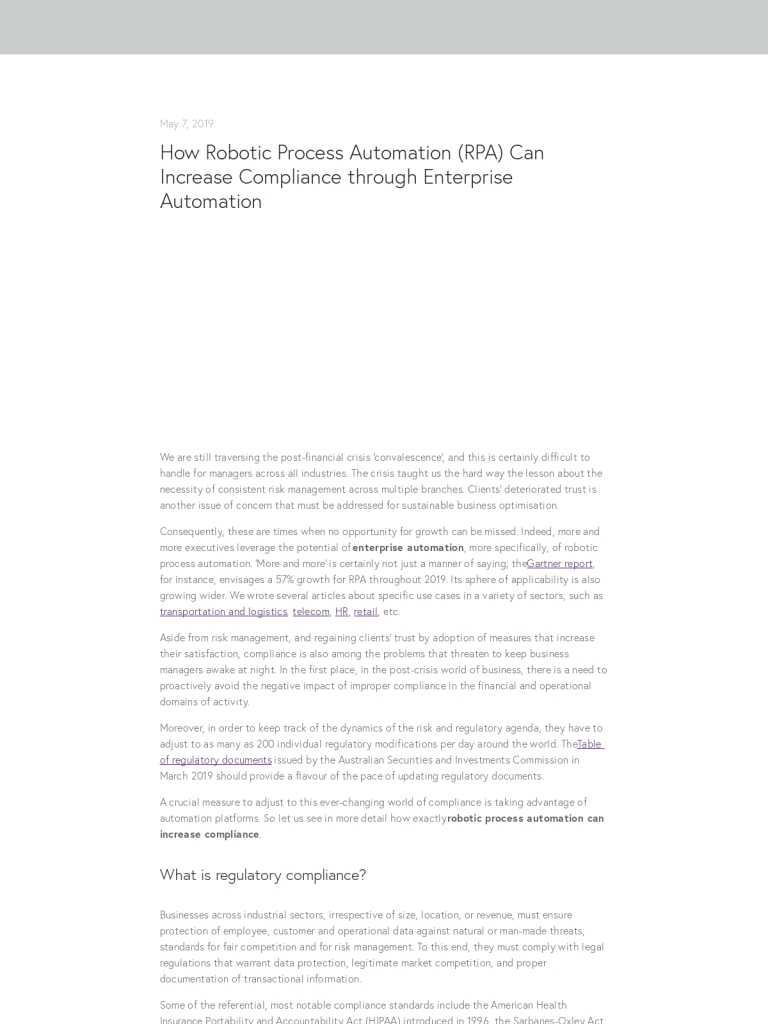How Robotic Process Automation (RPA) Can Increase Compliance through Enterprise Automation
Original post from https://www.cigen.com.au/cigenblog/

We are still traversing the post-financial crisis ‘convalescence’, and this is certainly difficult to handle for managers across all industries. The crisis taught us the hard way the lesson about the necessity of consistent risk management across multiple branches. Clients’ deteriorated trust is another issue of concern that must be addressed for sustainable business optimisation.
Consequently, these are times when no opportunity for growth can be missed. Indeed, more and more executives leverage the potential of enterprise automation, more specifically, of robotic process automation. ‘More and more’ is certainly not just a manner of saying; the Gartner report, for instance, envisages a 57% growth for RPA throughout 2019. Its sphere of applicability is also growing wider. We wrote several articles about specific use cases in a variety of sectors, such as transportation and logistics, telecom, HR, retail, etc.
Aside from risk management, and regaining clients’ trust by adoption of measures that increase their satisfaction, compliance is also among the problems that threaten to keep business managers awake at night. In the first place, in the post-crisis world of business, there is a need to proactively avoid the negative impact of improper compliance in the financial and operational domains of activity.
Moreover, in order to keep track of the dynamics of the risk and regulatory agenda, they have to adjust to as many as 200 individual regulatory modifications per day around the world. The Table of regulatory documents issued by the Australian Securities and Investments Commission in March 2019 should provide a flavour of the pace of updating regulatory documents.
A crucial measure to adjust to this ever-changing world of compliance is taking advantage of automation platforms. So let us see in more detail how exactly robotic process automation can increase compliance.
What is regulatory compliance?
Businesses across industrial sectors, irrespective of size, location, or revenue, must ensure protection of employee, customer and operational data against natural or man-made threats, standards for fair competition and for risk management. To this end, they must comply with legal regulations that warrant data protection, legitimate market competition, and proper documentation of transactional information.
Some of the referential, most notable compliance standards include the American Health Insurance Portability and Accountability Act (HIPAA) introduced in 1996, the Sarbanes-Oxley Act (SOX) of 2002, or the Federal Information Security Management Act (FISMA) of 2002, among others.
ISO 19600:2014 is the current global standard for compliance, which has been developed by the International Organization for Standardisation (the ISO). After the adoption of the Australian AS 3806-2006, it has been superseded by AS ISO 19600:2015 as the new standard meant to help businesses with compliance management.
Challenges posed by compliance with legal regulations
Changes in the regulatory market happen with high frequency, given the need to keep pace with an ever growing number of financial crimes and, hence, risky courses of financial operations. As a result, maintenance of regulatory compliance throughout those legislative meanders is a top challenge for businesses at a global scale.
In the year 2014 (when ISO 19600 was eventually adopted), Thomson Reuters mentions a total of 40.603 alerts issued for the year, with no expectations of decrease in the near future. The need to stay congruent with the evolution of compliance requirements towards becoming more and more complex is an obstacle that requires close consideration by business executives.
But this is not all. In order to get a relatively full picture of the obstacles that stand in the way of adherence to measures of regulatory compliance you should also take into account the inefficiencies that mark operational processes, the insufficient technological capacities and executive support, or scarcity of knowledge regarding potential improvements of compliance measures.
Thank you! An expert will get in touch soon.
How can RPA increase compliance?
As we were suggesting here, a wise selection of automatable processes is the most important step at the beginning of the automation journey. This step increases the likelihood to achieve the most beneficial results. Rule based, error-prone, low fault-tolerance, speed-sensitive, high volume processes with irregular labour requirements are among those to be considered.
Based on this trait list, many of the activities involved in compliance seem to be good candidates for automation. If you consider the repetitive, rule based, high volume nature of processes like employee compliance (e.g., licensing and registration, personal account dealings), surveillance (e.g., eCommunications and social media surveillance), or Know Your Customer (KYC), you have prima facie evidence at least for the utility of enterprise automation when it comes to compliance.
But there’s more. Assigning compliance tasks to software robots is a viable alternative to process externalisation by means of outsourcing and offshoring (which are also currently very popular). Since bots’ actions are saved in log files and can be reviewed at any time, use of RPA allows internal control of business operations; it streamlines your own employees’ proactive involvement in dealing with compliance issues (should they arise), and reviewing compliance statuses.
Workflow automation results in quasi-error free, consistent processing. This makes your business better prepared to go through external audits, with much less migraines for your workers. Since all information about process execution, encountered exceptions, and employees’ attempts to deal with the respective issues is recorded, it can be easily accessed whenever a regulatory audit happens.
What makes RPA a great fit for enterprise automation
Scaling up to enterprise level is a crucial step towards making the most out of robotic process automation. In fact, a Genpact white paper makes it clear that automation can serve well up to three quarters of enterprise processes. Improved compliance, alongside enhanced productivity or significant cost reductions, are among the top benefits that can be fully leveraged by expanding RPA use for the whole company.
If you decide to make this further step on the automation journey, it is very important to ensure that you choose a software provider which supports enterprise RPA. For instance, not requiring extensive coding and complex robot development are software traits that make it flexible and efficient when used at large scale. By ‘efficient’ we also mean that it is easily accessible even by employees who are less than experts when it comes to programming skills.
Equipping bots with queuing and scheduling features allows bulk processing of transactions, real-time oversight of bot actions, and demand- and priority-fit availability. Keeping comprehensive bot actions logs facilitates compliance with risk and security regulations, and audit preparedness.
Conclusion
The features of compliance processes such as document review, data consolidation, or invoice reconciliation, features like being high volume or rule based, recommend them for automation. Robotic process automation can increase compliance in several ways.
Detailed activity logs, for instance, make businesses ready for audit without relying on employees’ painstaking efforts and frustration tolerance. The scalability and flexibility of RPA makes it highly adaptable to the dynamics of work in business environments. Consequently, your business can adjust more easily to the high pace of change in compliance regulations, pace which is still on an ascending path. Also, it is a reasonable alternative to offshoring, thus providing an opportunity to capitalize on the internal control of business operations.
Last but certainly not least, leveraging RPA for compliance functions can be seen as a much needed way to practice, and get used to mixed teams composed of humans and machines. Assigning compliance tasks to bots is part and parcel of the way to scaling up to enterprise automation.
Leave a Comment
You must be logged in to post a comment.








